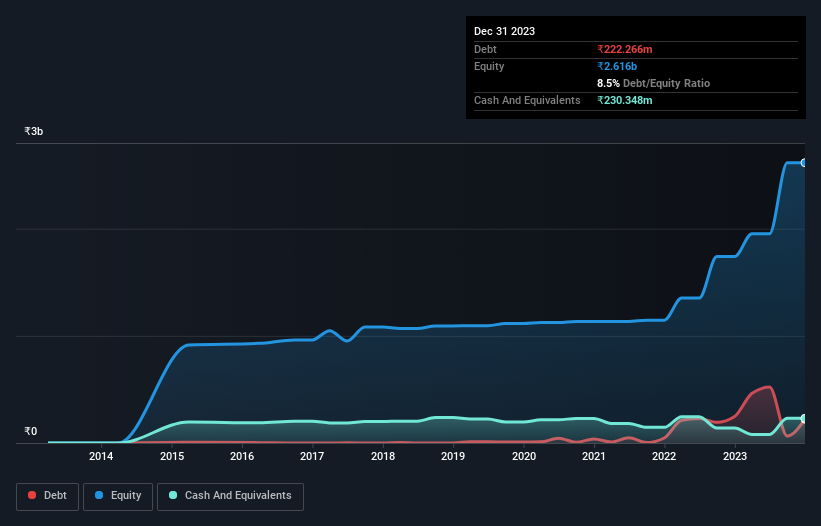Here's Why Lloyds Engineering Works (NSE:LLOYDSENGG) Can Manage Its Debt Responsibly

The external fund manager backed by Berkshire Hathaway's Charlie Munger, Li Lu, makes no bones about it when he says 'The biggest investment risk is not the volatility of prices, but whether you will suffer a permanent loss of capital.' When we think about how risky a company is, we always like to look at its use of debt, since debt overload can lead to ruin. Importantly, Lloyds Engineering Works Limited (NSE:LLOYDSENGG) does carry debt. But is this debt a concern to shareholders?
What Risk Does Debt Bring?
Debt and other liabilities become risky for a business when it cannot easily fulfill those obligations, either with free cash flow or by raising capital at an attractive price. If things get really bad, the lenders can take control of the business. However, a more usual (but still expensive) situation is where a company must dilute shareholders at a cheap share price simply to get debt under control. Of course, debt can be an important tool in businesses, particularly capital heavy businesses. When we examine debt levels, we first consider both cash and debt levels, together.
See our latest analysis for Lloyds Engineering Works
What Is Lloyds Engineering Works's Debt?
The image below, which you can click on for greater detail, shows that Lloyds Engineering Works had debt of ₹222.3m at the end of September 2023, a reduction from ₹247.4m over a year. However, its balance sheet shows it holds ₹230.3m in cash, so it actually has ₹8.08m net cash.

A Look At Lloyds Engineering Works' Liabilities
The latest balance sheet data shows that Lloyds Engineering Works had liabilities of ₹1.86b due within a year, and liabilities of ₹172.7m falling due after that. Offsetting these obligations, it had cash of ₹230.3m as well as receivables valued at ₹559.5m due within 12 months. So it has liabilities totalling ₹1.24b more than its cash and near-term receivables, combined.
Since publicly traded Lloyds Engineering Works shares are worth a total of ₹52.4b, it seems unlikely that this level of liabilities would be a major threat. Having said that, it's clear that we should continue to monitor its balance sheet, lest it change for the worse. Despite its noteworthy liabilities, Lloyds Engineering Works boasts net cash, so it's fair to say it does not have a heavy debt load!
Even more impressive was the fact that Lloyds Engineering Works grew its EBIT by 101% over twelve months. If maintained that growth will make the debt even more manageable in the years ahead. The balance sheet is clearly the area to focus on when you are analysing debt. But it is Lloyds Engineering Works's earnings that will influence how the balance sheet holds up in the future. So if you're keen to discover more about its earnings, it might be worth checking out this graph of its long term earnings trend.
Finally, a business needs free cash flow to pay off debt; accounting profits just don't cut it. While Lloyds Engineering Works has net cash on its balance sheet, it's still worth taking a look at its ability to convert earnings before interest and tax (EBIT) to free cash flow, to help us understand how quickly it is building (or eroding) that cash balance. During the last two years, Lloyds Engineering Works burned a lot of cash. While that may be a result of expenditure for growth, it does make the debt far more risky.
Summing Up
While it is always sensible to look at a company's total liabilities, it is very reassuring that Lloyds Engineering Works has ₹8.08m in net cash. And it impressed us with its EBIT growth of 101% over the last year. So we don't have any problem with Lloyds Engineering Works's use of debt. When analysing debt levels, the balance sheet is the obvious place to start. However, not all investment risk resides within the balance sheet - far from it. For instance, we've identified 2 warning signs for Lloyds Engineering Works that you should be aware of.
If, after all that, you're more interested in a fast growing company with a rock-solid balance sheet, then check out our list of net cash growth stocks without delay.
New: AI Stock Screener & Alerts
Our new AI Stock Screener scans the market every day to uncover opportunities.
• Dividend Powerhouses (3%+ Yield)
• Undervalued Small Caps with Insider Buying
• High growth Tech and AI Companies
Or build your own from over 50 metrics.
Have feedback on this article? Concerned about the content? Get in touch with us directly. Alternatively, email editorial-team (at) simplywallst.com.
This article by Simply Wall St is general in nature. We provide commentary based on historical data and analyst forecasts only using an unbiased methodology and our articles are not intended to be financial advice. It does not constitute a recommendation to buy or sell any stock, and does not take account of your objectives, or your financial situation. We aim to bring you long-term focused analysis driven by fundamental data. Note that our analysis may not factor in the latest price-sensitive company announcements or qualitative material. Simply Wall St has no position in any stocks mentioned.
About NSEI:LLOYDSENGG
Lloyds Engineering Works
Provides engineering products and services in India.
Excellent balance sheet with acceptable track record.
Similar Companies
Market Insights
Community Narratives



